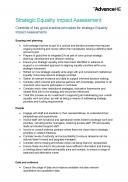
Back to practical tools and information

Checklist of key good practice principles for strategic Equality Impact Assessment
Download the checklist
Download
Scoping and planning
- Acknowledge that this is part of a cyclical and iterative process that requires ongoing monitoring and review rather than necessarily having a definitive start and end point.
- Prepare in good time to integrate EIA as part of core cyclical strategic planning, development and decision making.
- Ensure your strategic equality aims have been identified in advance to support a co-ordinated approach to aligning equality priorities within your strategic framework.
- Reflect on how strategic equality aims align with and complement institutional Equality Outcomes linked to strategic priorities.
- Gather all relevant evidence and data to support informed decision making.
- Consider which internal and external partners with knowledge, expertise or an important view need to participate or contribute.
- Consider which other institutional strategies, evaluation frameworks and related EIAs link to the strategy and should be referenced.
- Treat this process as an investment in supporting and addressing your overall equality work and aims, as well as being a means of addressing strategic priorities and funding requirements.
People
- Engage with staff and students or their representatives, to understand their perspectives and experiences.
- Involve staff with functional and operational remits linked to strategic work and priorities, including senior managers, widening access staff, HR and equality leads and student support staff.
- Involve or consult external partners where there are close links to strategic priorities or related initiatives.
- Consider levels of authority and accountability to ensure decisions can be actively taken forward and progress managed.
- Consider who’s missing and whose views not being heard or represented.
- Ensure those involved in the process have sufficient information and training or briefing about institutional equality aims and context, to ensure a range of balanced and alternative views.
Data and evidence
- Ensure the range of data and evidence available includes relevant quantitative and qualitative data.
- Ensure data and evidence covers all PCs, widening access and socio- economic groups and where possible, provides an understanding of how these issues intersect.
- Look for trends and outcomes across a range of this information and data, linked to core evaluation processes where relevant.
- Acknowledge where data gaps exist and consider how they will be addressed.
Assessment and decisions
- Use the range of data and evidence to inform your understanding of current progress, achievements and impact across the range of strategic and equality priorities and what this suggests in terms of future direction and decisions.
- Where do opportunities exist to eliminate discrimination, advance equality or foster good relations in line with your legal duties?
- Consider whether your current approach fits with strategic institutional equality aims, priorities and equality outcomes and whether there are opportunities to better align this work.
- Challenge the status quo and use self-reflection; question should it be like this, or does it have to be like this and consider alternatives.
- Consider risks and barriers: what is not currently addressed well, shows little or no impact, or is missing from the agenda? How can these risks be mitigated or addressed?
- Consider unintended consequences; is current direction resulting in or contributing to an unexpected impact? How can you address this?
- Are there approaches you haven’t considered? What’s preventing action for particular PCs or areas of work and can you find ways to overcome or move towards addressing any challenges?
- Ensure the results of your assessment are recorded and communicated to other functions, staff or teams affected.
- Ensure there is a clear mechanism for overall accountability, for taking forward the agreed action and for continuing to review progress.
Embedding the results of the assessment
- Use the results and decisions from your assessment to review, set or adjust and represent your intended equality direction within the strategy.
- Ensure you understand how the strategy or policy direction and activities map against other institutional strategies, operational plans and policies.
- Coordinate any necessary work to ensure the intended direction you have set through the EIA process, is communicated to staff or teams who need to know and is effectively mainstreamed into their work, planning and links are made to other relevant EIAs or institutional frameworks.
Monitoring and review
- Ensure a robust process of ongoing monitoring, evaluation and review that enables consideration and understanding of the impact and effectiveness of equality aims and direction and whether these have been implemented as intended in practice.
- Although many equality initiatives require longer term periods to judge impact and effectiveness, be prepared to recognise where decisions are not working and to take any action needed.
- Ensure that iterative ongoing monitoring and review effectively feeds into other areas of institutional strategy, business and frameworks to support alignment and consistency of your institutional approach to equality.